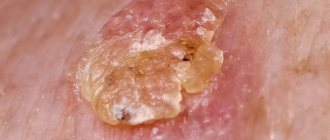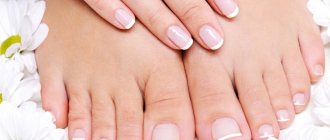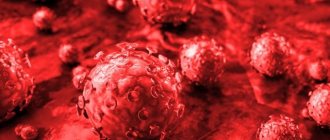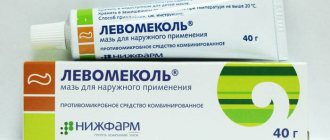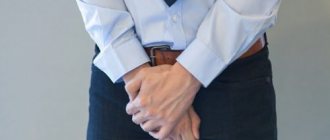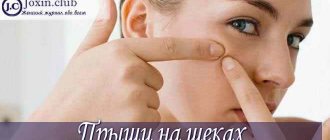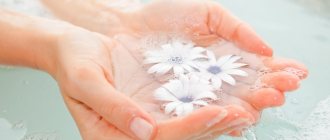- October 31, 2018
- Dermatology
- Anatoly Ivanov
In this article we will look at how to get rid of warts on the palm.
For many people, warts on the skin become a big problem. These neoplasms are very unpleasant, cause severe discomfort and look unattractive. Warts on the palm can be treated in several effective ways. All of them allow you to achieve good results.
It must be said that such warts are not malignant. Before starting treatment, you should undergo a medical consultation.
Features
A wart on the palm may look like a simple callus. However, such neoplasms have several distinctive features. These include:
- the color of warts is close to the skin tone;
- this neoplasm is approximately one centimeter, rarely larger in diameter;
- has a compacted structure;
- warts of this type are mostly single, but several small ones may appear around one large one;
- if a neoplasm has appeared, it has a soft and transparent surface; when it is in a neglected state, it is covered with a thick stratum corneum;
- pain can occur only when the roots of the wart penetrate the muscle layer; in such cases, black dots appear on the surface of the neoplasm.
Why did a wart appear on my palm? This is interesting to many.
How to distinguish from other formations
The cause of warts on the fingers is the papillomavirus in combination with a weakened immune system. Moles appear on the hands for other reasons, but they can resemble papillomas. Signs by which neoplasms can be distinguished:
- If the mole has never been injured, it has the correct outline. A wart initially looks rough on the skin.
- The pathological growth is harsh to the touch. Moles are elastic, smooth, and do not have a scaly surface.
- The color of moles is almost always pleasant, light or dark brown, less often black. The shade of papillomas is close to flesh-colored; it can be yellow, pink and gray.
Only a dermatologist can completely determine the origin of neoplasms on the skin of the hands. Before you remove a mole-like growth yourself, you should consult a doctor. This is necessary to prevent its degeneration into a malignant tumor.
Causes
The only and main cause of the occurrence of neoplasms on the human body is damage to skin areas by the papilloma virus. The vast majority of people are carriers of this virus, but not everyone develops warts.
This virus can enter the human body for the following reasons:
- direct contact with a carrier of the virus;
- weakened immune system;
- microcracks on the human body;
- failure to comply with personal hygiene standards;
- situations of stress.
Hands are involved in all everyday contacts, for example, holding handrails in public transport, handrails in houses, opening doors, etc.
Warts on the palm most often form on the inside of the palm, on the fingers and between them. This happens because these areas are among the most traumatized.
What does a wart on the palm look like?
What are warts?
A wart is a skin growth with a rough, friable surface caused by the human papillomavirus (HPV). The virus causes the affected skin to produce too much keratin, causing the rough growth to appear. They usually appear on the arms and legs, but can form on any area of the skin. Warts are contagious and, upon contact, can easily spread to other areas of your face or body, or to another person. Once infected, the wart may take several weeks or months to appear on the skin.
Warts spread quickly when they come into contact with healthy skin, either from another person or from other areas of your face or body. The formation can also appear through indirect contact with objects that have come into contact with the affected area of the skin - this could be a towel or the floor of a swimming pool. Since warts are highly likely to become infected, it is important to begin treatment as quickly as possible to prevent them from spreading to other areas of the skin or passing on to another person.
Varieties
Flat warts on the palm or simple papillomas may appear. The former are characterized by a rounded shape, small size and a smooth, even surface. They usually grow yellowish or flesh-colored. Such neoplasms predominantly appear on the palms of young people from ten to thirty years of age.
The latter are characterized by local insensitivity, size from three to ten millimeters. They resemble oval dense nodules in appearance. The color is dark brown, yellow or pinkish, but most often the same as the skin. In all cases, there is a main wart, which is surrounded by small ones - its daughter growths. When large warts are removed, small warts will disappear on their own.
If a large number of small warts on the palms grow and connect, then mosaic growths are formed that have a keratinized dense structure and a dirty gray color. Due to multiple foci, it is difficult to treat.
Types of warts in children
Warts differ on different parts of the body due to the structure of the skin and the HPV stamp. To determine the type of growth formed and the method of treatment, a consultation with a doctor is necessary. This is also necessary to exclude diseases with similar symptoms, such as: molluscum contagiosum, lichen planus, warty tuberculosis and others.
Experts identify the following types of papillomas in children.
- Common (vulgar) wart. Most often, such warts appear on a child’s hands. Small growths with a keratinized surface. They differ in color from healthy skin; they can be yellow or even gray.
- Plantar wart in a child. They often appear in children with very sweaty feet or those involved in active sports. The growth has a soft core surrounded by hard, keratinized skin.
- Flat warts. A flat plaque with a smooth surface of pink or yellowish color. May appear in children or adolescents during hormonal changes during puberty. Most often observed on the face, less often on the legs or arms.
- Filiform wart. Papilloma that appears on the mucous membranes or in its area (mouth, nose area). Very rare.
Drug treatment
Warts do not always need to be treated immediately. Sometimes they go away on their own. A single growth indicates low virus activity. In this case, you can not take any measures to remove it for some time. But it is necessary to observe its dynamics. You can help your body a little, take a course of vitamin supplements, and get more rest. If the growths are multiple, it means that the activity of the virus is increased, and they are unlikely to disappear on their own.
Treatment of this kind should only be selected by a doctor: he can draw up a competent drug therapy regimen to effectively eliminate growths on the skin. He will take into account the individual characteristics of the patient and the presence of contraindications.
The following groups of drugs are currently used to combat warts:
- immunomodulatory and antiviral medications;
- cryotherapy drugs;
- keratolytics - drugs that affect the structure of skin tissue;
- necrotic local medications.
Disease prevention
- Avoid touching the wart and avoid contact with people with this infection;
- Do not share personal items such as razors, towels, socks, shoes with another person. You don’t know how healthy a person is and whether he is a carrier of the virus;
- do not walk barefoot in public places: a swimming pool, bathhouse, sauna, beach are favorable places to get acquainted not only with warts, but also with fungus;
- keep your feet dry. If your feet sweat a lot, change your socks more often;
- to prevent the appearance of plantar warts, monitor the condition of your feet and do not injure the skin during a pedicure;
- wash your hands more often;
- Wear rubber flip-flops when going to the public shower after training.
Immunomodulators
The first group includes the following medications:
- "Isoprinosine" are tablets that have an immunomodulatory effect. Available from pharmacies without a prescription. The course of use is two weeks, three times a day, two tablets.
- "Viferon" - due to the presence of human interferon in the composition, the drug has a local immunomodulatory effect without being absorbed into human blood. Produced in the form of an ointment or gel, it is an over-the-counter product. In childhood, similar candles can be used.
- "Kipferon" is a drug with antibacterial, antiviral, anti-inflammatory and immunomodulatory effects. Helps quickly cope with HPV and eliminate warts. Produced in the form of suppositories, it can be used to treat adults and children.
- "Acyclovir" - tablets and ointment to combat neoplasms, produce a clear antiviral effect. It is effective both for the treatment of papillomas and for their prevention.
A representative of cryotherapeutic drugs, Cryopharma, is produced in the form of an aerosol and has a special applicator. The drug is based on propane and dimethyl ether, which, like the cryodestruction procedure, freeze the wart, causing its death. This product is quite easy to use: the required amount of medication is applied to the applicator and applied to the papilloma for the period indicated in the instructions for use. It is forbidden to use it by nursing and pregnant women, as well as children under four years of age.
Keratilytics
The group of keratilytics includes the following pharmaceutical drugs:
- The “Salipod” patch is an effective remedy based on salicylic acid, which allows you to very quickly remove warts on the feet, papillomas on the palms and any other growths on the skin.
- "Feresol" is a solution based on tricresol and phenol. It can remove small papillomas after the first use; larger growths require several procedures. Precautions must be taken as healthy tissue can be burned.
- “Verrukacid” - the phenol in its composition is in high concentration, and therefore the drug quickly eliminates the cells of the neoplasm being treated. It should be taken into account that there is a high probability that if it comes into contact with healthy skin, a burn will form.
- "Duofilm" is a combined type dermatological preparation, the active components of which are lactic and salicylic acids. You need to be very careful and pre-prepare the area to be treated.
- “Supercleaner” is an effective, inexpensive and popular product based on sodium bicarbonate, hydroxide and chloride. The wart must be steamed and dried before applying it.
Local necrotic agents
Local necrotic agents are:
- "Solcoderm" is a combination drug that has a cauterizing and mummifying effect. The active ingredients are nitric, lactic and acetic acids, oxalic acid dihydrate and copper nitrate. Available in the form of a solution for external use.
- "Condilin" is an effective remedy based on podophyllotoxin, which stops the cell division of warts and causes their death. It is mainly used to eliminate genital warts, but can be prescribed for the treatment of ordinary neoplasms.
- "Vartek" is the active component of podophyllotoxin. It is an analogue of the previous remedy, so it has a mummifying, cytostatic and cauterizing effect, and reduces inflammatory reactions. If this treatment is unsuccessful within two months, you should visit a dermatologist.
Treatment of warts and condylomas
Most warts and condylomas go away on their own and do not require treatment. Often the best option is to simply leave them alone. This is especially true for children, as some treatment options may be painful or cause side effects.
However, you should consider treatment if the wart or growth is painful, has an unpleasant appearance, or does not go away for a long time. Although treatment may help get rid of warts or growths faster, no method is 100% effective. There is also no data available on which treatment is best.
Cryotherapy
This treatment method uses liquid nitrogen to freeze and remove the wart. The cold temperature kills the cells inside the wart and cuts off blood flow to it. As a result, the wart cells die and the wart falls off on its own. Freezing lasts from 5 to 30 seconds depending on the equipment used and the size and location of the wart.
The cryotherapy procedure may need to be repeated every 1-4 weeks for three months. The process can be painful and the skin may develop blisters or scars. This treatment is not recommended for children: it causes pain, which will make it difficult to hold the child in a still position for the procedure.
Laser removal
A concentrated laser beam is directed at the wart. The laser energy heats the blood vessels that support the growth of the wart; as a result, they are destroyed and block blood access to the wart. This deprives the wart of the substances it needs to grow, and after a few days it falls off on its own.
Surgical removal
The wart is carefully excised using a surgical scalpel. This procedure can be performed under local anesthesia. For this purpose, a small incision is made on the skin. This treatment method allows you to immediately remove the wart. After the procedure, pain is possible, and a scar may remain at the site of the removed formation.
Self-medication
Although there is no evidence that this method works, you can get rid of the wart by covering it with duct tape. The adhesive tape is left on for six days, then the wart is soaked and the dead skin is rubbed off with a nail file or pumice stone. The tape must be removed at night and reapplied the next day. A number of these procedures may need to be repeated over a period of two months until the wart disappears. This method is not recommended for horny warts.
Drug treatment
There are many creams, gels and medicated patches available to treat warts and growths - these can be purchased at the pharmacy. Many of them contain salicylic acid. It helps soften the rough outer layer of the wart or growth. Do not apply this product to warts on your face - it may cause irritation or leave scars.
If you use this method, make sure to only apply the cream to the wart or growth itself. Be careful not to get it on the area around the wart, otherwise it may irritate healthy skin. Once or twice a week, remove excess rough skin using a nail file or pumice stone. This procedure may have to be repeated for up to three months.
Creams containing imiquimod can be used on sensitive areas of the skin, for example to get rid of warts on the face and genitals. Imiquimod encourages the immune system to recognize and attack the virus that causes warts. Retinoid creams, which are often prescribed to treat acne, can also be used to treat warts. Some medications contain podophyllotoxin. Do not use retinoids or podophyllotoxin if you are pregnant, trying to become pregnant, or breastfeeding.
Surgical treatment
Warts on the palm are removed surgically under local anesthesia using a scalpel.
There are several methods of surgical intervention to eliminate tumors:
- Cryotherapy (liquid nitrogen). This procedure is quite effective and fast, and does not leave any traces behind. It happens that you need to repeat the treatment. If there is insufficient amount of liquid nitrogen, the inflamed area will become sore for several days and a bubble will form.
- Electrocoagulation. This method is used in the treatment of tumors on the palm, fingers and between them. The procedure is carried out using high-frequency currents. There is no blood after the procedure. This method is used in the presence of small papillomas without a deep root.
- Removal of warts with laser. This treatment method is effective and painless. After the operation, small scars may remain, but the skin recovers quite quickly, and there is no need to worry about this.
Laser wart removal is very popular now.
How to get rid of warts on hands?
Sometimes you don't need to do anything, warts disappear on their own. But their viral nature should be taken into account. Every wart is a source of new ones, and not only for the “owner” of the warts, but also for those around him. In addition, warts are not aesthetically pleasing and, located on folds or protruding places, can interfere, irritate or cause injury. Then the wart becomes an additional gateway for infection. But the presence of warts is an indicator of a certain weakness of the immune system.
Therefore, you need to consult a dermatologist. After analyzing the tumors, he will tell you how to remove warts on your hands and prescribe treatment. The skin on the hands is denser and rougher than on the face or body, so the effect on warts on the hands can be more aggressive.
Modern medicine in most cases copes with this problem quite quickly and without consequences. Treatment methods for warts are aimed at removing them. Laser therapy, cryotherapy (freezing with liquid nitrogen), and electrocoagulation are practiced. In principle, these procedures are painless, but if there are many warts or they are large in size, local anesthesia may be used.
More gentle methods include ointments and patches that are applied or glued directly to the wart. But it should be taken into account that radical methods (removal of warts) bring results quickly, often in one procedure, while ointments and patches will need to be used for 2-3 months.
If you go to the country in the summer, you can try a simple and affordable method of treatment with celandine juice. This plant is quite widespread in the wild. After tearing off a leaf of celandine, lubricate the warts 2-3 times a day. It will take 2-3 months, but there are no costs or inconveniences. The action of celandine is based on suppressing growth and destroying “unnecessary” cells. Be sure to seek approval from a dermatologist before starting treatment.
We looked at local methods for treating warts on the hands, but the main reason for their appearance is a decrease in immunity. Therefore, it is a good idea to apply general measures as well. The doctor will most likely, in addition to local treatment, prescribe vitamins for warts and immunomodulators, for example, echinacea preparations, a complex of vitamins, and also vitamins A and C separately.
Traditional methods
To get rid of tumors using traditional methods, you need to steam your palms in water and wipe them with a clean and dry cloth. The most famous method of treating warts is celandine juice. Compresses are applied at night. Such procedures must be carried out very carefully so that the product does not get on healthy areas of the skin, since celandine juice is poisonous and can leave deep and severe burns.
In addition, onions are often used, which are peeled, cut and filled with 70% vinegar essence. A piece of onion is used to make a bandage overnight and remove in the morning.
Specifics of removing warts on the palm of a child
When a child develops a wart, it must be removed using the same methods as in adults. When treating children, immunomodulatory and antiviral medications and local preparations (gels, ointments, solutions) are prescribed. However, only a specialist can prescribe them, since not all products can be used by children under seven years of age. Other contraindications must be taken into account.
To quickly remove papillomas located on the back of the hand, fingers, inner surface or other places, children may be recommended to use hardware - electrocoagulation, laser therapy, cryodestruction and removal with a radioknife. Traditional recipes can also help, but using them without regular supervision and approval of a doctor is prohibited.
We looked at the causes and treatment of warts on the palms.
Causes of warts
There is a belief among parents that warts appear in children after contact with frogs, so they forbid their children from catching frogs. This is a real myth. In children, warts appear not as a result of contact with a frog, but as a result of hypothermia of the hands. Warts that appear on the hands of older people are not contagious, but they look more disgusting. They are scaly plaques with an uneven surface. Warts differ from the basic skin tone of the hands and can increase in size and even merge.

